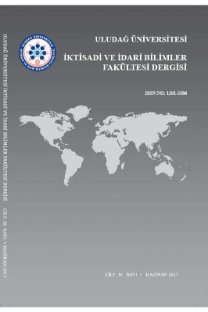Transition from education to first real job in Turkey: An empirical research on the Uludağ University Econometrics Department graduates
Son yıllarda, ülkenin gelişmişlik düzeyi ne olursa olsun işsizlik önemli bir sorun haline geldi. Türkiye’nin işsizlik oranları sürekli yüksek bir düzeydedir ve her nedense arzu edilen düşük düzeylere indirilmesi mümkün olmamaktadır. Özellikle, emek piyasasına hiç girmemiş işsizlerin toplam işsizlik içindeki görünüşünde sürekli bir artış vardır. Bu çalışma Türkiye’deki Ekonometri bölümü mezunlarının istihdam fırsatlarını artıran kritik faktörlerin belirlenmesini amaçlamıştır. Özellikle, Ekonometri bölümü mezunları için ilk gerçek işi bulmanın bileşenlerini açıklayabilecek değişkenler üzerinde odaklandık. Toplanan verilerden Lojistik regresyon tahmin edildi. Araştırma sonuçları, iş deneyimi, ek eğitim, sosyal topluluk, eğitim türü, yaş ve aile teşviki değişkenlerinin ilk gerçek işi bulmada istatistiksel önem taşıdığını göstermektedir.
Türkiye’de eğitimden ilk gerçek işe geçiş: Uludağ Üniversitesi Ekonometri Bölüm mezunları üzerinde bir ampirik araştırma
In recent years, unemployment has become a fundamental problem regardless of the level of development of the country. The unemployment rates in Turkey are constantly at a high level and for whatever reasons; it has not been possible to make the reduction to the desired low levels. In particular, there is a continuous increase in the total unemployment figures of unemployed who have never entered the labor market. This study aimed to determine the critical factors that increase employment opportunities for Econometrics department graduates in Turkey. There was particular focus on the variables that may explain the determinants of finding a first real job for graduates from the Econometrics Department. Logistic regression was estimated from the collected data. The research findings show that the variables of business experience, additional education, social community, education type, age, and family stimulus show statistical significance in finding a first real job.
___
Andrews, M. J.; Bradley, S. & Stott, D. (2002), “Matching the Demand for and Supply of Training in the School-To-Work Transition”, The Economic Journal, 112, 201-219.Belen, E. (2008), Gençler: Eğitimsiz, İşsiz ve Atıl. Tisk-İşveren Dergisi, Vol. 46. No. 1. pp. 80–82.
Birleşmiş Milletler Kalkınma Programı, (United Nations Development Programme- UNDP) “2008 Türkiye İnsani Gelişme Raporu: Türkiye’de Gençlik”. Available from http://www.unpd.org.tr/publicationsDocument/NHDR_Tr.pdf [Accessed 2 Marc 2009].
Bulutay, T. (1995), “Employment, Unemployment and Wages in Turkey”, Ankara: State Institute of Statistics and International Labor Office.
Chuang, H. L. (1999), “Estimating the determinants of the unemployment duration for college graduates in Taiwan”, Applied Economic Letters, 6, 677–681.
Cox, D. R. (1958), “The Regression Analysis of Binary Sequences”, Journal of the Royal Statistical Society, Series B (Methodological), 20, 215–242.
Eckstein, Z. & Wolpin, K. I. (1995), “Duration to First Job and the Return to Schooling: Estimates from a Search-Matching Model”, The Review of Economic Studies, 62, 263–286.
Ehrenberg, R. G. & Smith, R. S. (1997), Modern Labor Economics, London: Addison-Wesley Educational Publications Inc.
Elliot, R. E. (1991), Labor Economics: A Comparative text, London: McGraw-Hill Book Company.
Ercan, H. (2007), Türkiye’de Gençlerin İstihdamı, Ankara: Uluslararası İstihdam Ofisi.
Flannery, T. P., Hofrichter, D. A. & Platten, P. E. (1996), People, Performance and Pay, New York: The Free Press.
Gujarati, D. N. (2003), Basic Econometrics, New York: Mc-Grawhill Companies.
Harrel, F. E. Jr. (2001), Regression Modeling Strategies, New York: Springer.
Hosmer, D. W. & Lemeshow, S. (2000), Applied Logistic Regression, New York: John Wiley & Sons.
Jenkins, S. P. & Serano, G. C. (2004), “Re-employment Probabilities for Spanish Men: What Role does the Unemployment Benefit System Play?”, Oxford Bulletin of Economics and Statistics, 66, 239-261.
Kaufman, B. E. (1986), The Economics of Labor Market and Labor Relations, New York: CBS College Publications.
Lassibille, G., Gomez, L. N., Ramos, I. A. & Sanchez, C. (2001), “Youth transition from school to work in Spain”, Economics of Education Review, 20, 139– 149.
Leech, N. L., Barrett, K. C. & Morgan, G. A. (2004), Spss for Intermediate Statistics: Use and Interpretation. Manwah New Jersey: Lawrance Erlbaum Associates Publishers.
Menard, S. (2002), Applied Logistic Regression Analysis. California: Sage Publications.
Morgan, S. P. & Teachman, J. D. (1988), “Logistic Regression: Description, Examples, and Comparisons”, Journal of Marriage and Family, 50, 929– 936.
Ogawa, K. & Tansel, A. (2005), “Transition from Education to Labor Market in Turkey”, Journal of International Cooperation Studies, 12(3), 113-143.
Pollmann-Schult, M. & Büchel, F. (2005), “Unemployment Benefits, Unemployment Duration and Subsequent Job Quality: Evidence from West Germany”, Acta Sociologica, 48(1), 21-39.
Rima, I. H. (1996), Labor Market in a Global Economy: An Introduction, New York: M. E. Sharp Inc.
Stock, J. H. & Watson, M W. (2007), Introduction to Econometrics, Boston: Pearson Addison Wesley.
Strauss, D. (1992), “The Many Faces of Logistic Regression”, The American Statistician, 46, 321–327.
Şenses, F. (1994), “Labor Market Response to Structural Adjustment and Instutional Pressures: The Turkish Case”, Metu Studies in Development, 21(3), 405- 448.
Taşçı, H. M. & Tansel, A. (2005), “Youth Unemployment Duration in Turkey”, Metu Studies in Development, 32, 532-545.
Turk Stat, “2008 Employment Statistics”, Available from www.turkstat.gov.tr [Accessed 2 Marc 2009].
Van den Berg, G. J. & Van Ours, J. C. (1999), “Duration Dependence and Heterogeneity in French Youth Unemployment Durations”, Journal of Population Economics, 12, 273-285.
Walker, S. H., & Duncan, D.B. (1967), “Estimation of the Probability of an Event as a Function of Several Independent Variables”, Biometrika, 54, 167–179.
Wolpin, K. I. (1987), “Estimating a Structural Search Model: The Transition from School to Work”, Econometrica, 55, 801–817.
- ISSN: 1301-3386
- Yayın Aralığı: Yılda 2 Sayı
- Başlangıç: 2018
Sayıdaki Diğer Makaleler
An approach to measuring brand loyalty in the Turkish automotive sector
Girişimci üniversite modeli ve Türkiye
Dolaysız yabancı sermaye yatırımları ve dış ticaret bilançosu: Türkiye üzerine bir uygulama
GÜVEN DELİCE, YUNUS EMRE BİROL
Faaliyet tabanlı maliyetleme yönteminin inşaat taahhüt işletmelerinde uygulanması
Gelir ve co2 emisyonu ilişkisi: Panel birim kök ve eşbütünleşme testi
Mülteciler ve Ulusal/Uluslararası güvenlik
Türkiye, Çin ve Hindistan’ın sektörel rekabet gücü üzerine karşılaştırmalı bir inceleme
LEVENT KÖSEKAHYAOĞLU, Gökhan ÖZDAMAR
Kobi’lerde süreç yönetimi uygulamalarının incelenmesi: Sakarya ili I.Organize Sanayi Bölgesi örneği
